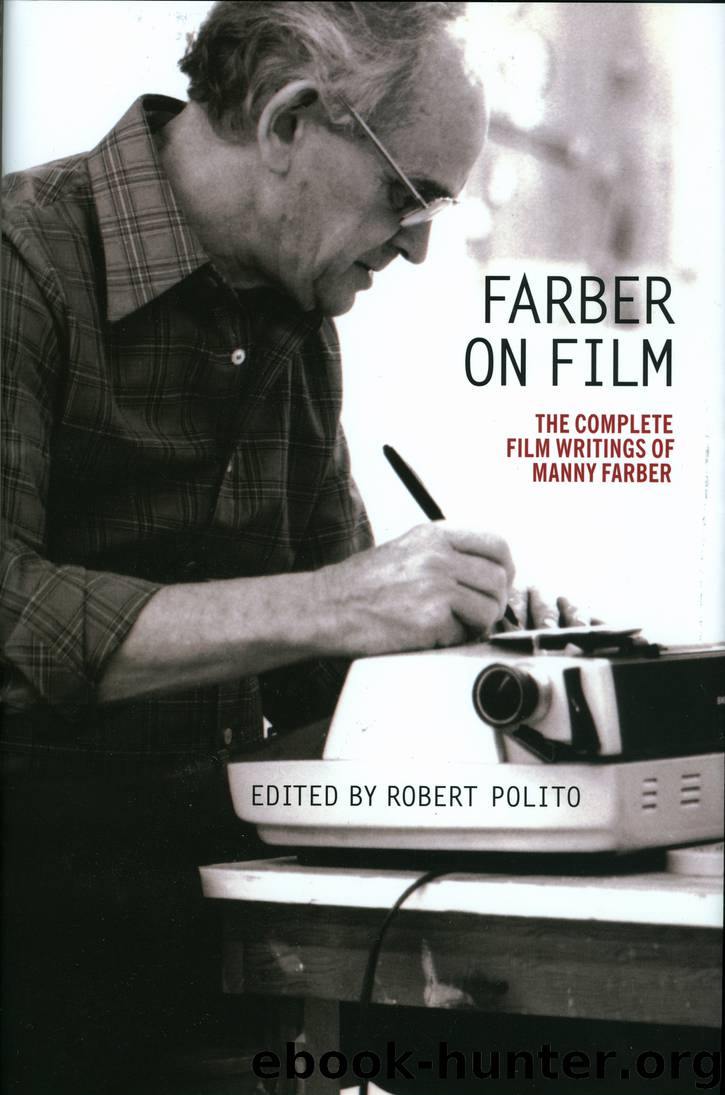Farber on Film by Farber Manny

Author:Farber, Manny
Language: eng
Format: epub
Publisher: Library of America
Published: 2015-03-30T16:00:00+00:00
A 1961 cavalry film that is like an endless frontier-day pageant, Two Rode Together has the discombobulated effect of a Western dreamt by a kid snoozing in an Esso station in Linden, New Jersey. Two wrangling friends, a money-grubbing marshal (Jimmy Stewart) and a cavalry captain (Richard Widmark, who has the look of a ham that has been smoked, cured, and then coated with honey-colored shellac), seek out a Comanche named Parker and trade him a stunningly new arsenal of guns and knives for a screaming little Bowery Boy with braids who’s only bearable in the last shot when the camera just shows his legs hanging limply from a lynching tree.
The movie’s mentally retarded quality comes from the discordancy and quality of the parts: it’s not only that they don’t go together, they’re crazy to start with. Each woman and Indian is from a different age in operetta and a different part of the globe. The Indians include an overdeveloped weight-lifter, a sad Pagliacci trying hard not to let his flabby stomach show, plus the above Leo Gorcey tough with his histrionic impression of a monkey on hot coals. The movie wobbles most with Widmark, embarrassed but strangely submitting to courting scenes with Shirley Jones that are filled with temerity and wide-eyed hopefulness. His tomboy sweetheart, a fraulein out of The Student Prince with two thick long yellow braids and enough make-up to equal Widmark’s, has a fixation on a music box and runs to it at every chance.
The movie is a curious blend of modern blat and a senile impression of frontier culture that derives from the cheapest and oldest movies about prerailroad days in Indian territory. There is a wild, non sequitur quality about the courtship, frontier dialogue, and spitting, thin-skinned, stupidly stubborn Indians taking place in a free-for-all atmosphere in which not one detail or scene goes with another. In general, it is Widmark and Stewart, like two Pinter characters, separated out from a stiff (despite the yelling and flouncing), corny TV-styled production going on behind them. Throughout, these actors barely listen to each other, and, affecting a curious, dragged out, folksy dialect, they take up great amounts of space with words that are from Dimwit’s Land. “No! She didn’t kill herself, ladies and gentlemen. Not because she was a coward, but because her religion forbade her. Sometimes, it takes more courage to live than to die.” Facetiously delivering this speech, Stewart is operating here in a feeble, tensionless mock-up of an officers’ cotillion at the local fort. (I kept wondering, Why are they dragging in a dance? Could it be to squeeze that white hypocrisy speech into the remains of a script previously taken up with removing the normal skin tone, stealth, dignity, and clothes sense from Indians?)
It is filled with cliché conceptions: of an Indian camp, a Texas Guinan seenioreeta who owns the saloon and the town, slow-witted people, an innocent tomboy heroine throwing a barrel of flour over the two Cleggs who come courting her, country bumpkins having a fight in the woods.
Download
This site does not store any files on its server. We only index and link to content provided by other sites. Please contact the content providers to delete copyright contents if any and email us, we'll remove relevant links or contents immediately.
The Kite Runner by Khaled Hosseini(5061)
Gerald's Game by Stephen King(4556)
Dialogue by Robert McKee(4305)
The Perils of Being Moderately Famous by Soha Ali Khan(4156)
The 101 Dalmatians by Dodie Smith(3440)
Story: Substance, Structure, Style and the Principles of Screenwriting by Robert McKee(3384)
The Pixar Touch by David A. Price(3344)
Confessions of a Video Vixen by Karrine Steffans(3230)
How Music Works by David Byrne(3157)
Fantastic Beasts: The Crimes of Grindelwald by J. K. Rowling(2975)
Harry Potter 4 - Harry Potter and The Goblet of Fire by J.K.Rowling(2974)
Slugfest by Reed Tucker(2923)
The Mental Game of Writing: How to Overcome Obstacles, Stay Creative and Productive, and Free Your Mind for Success by James Scott Bell(2835)
4 - Harry Potter and the Goblet of Fire by J.K. Rowling(2639)
Screenplay: The Foundations of Screenwriting by Syd Field(2561)
The Complete H. P. Lovecraft Reader by H.P. Lovecraft(2499)
Scandals of Classic Hollywood: Sex, Deviance, and Drama from the Golden Age of American Cinema by Anne Helen Petersen(2453)
Wildflower by Drew Barrymore(2431)
Robin by Dave Itzkoff(2368)
